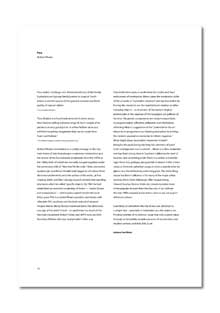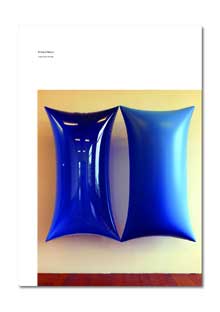 |
|||||||||
|
|
| ...Publications: Annual | ...The Physics Room Annual 2003 | ||||||||||||||
|
Para Para rubber tree: large tree (Hevea brasiliensis) of the family Euphorbiaceae (spurge family),native to tropical South America and the source of the greatest amount and finest quality of natural rubber. “Para Rubber is a franchised network of stores across New Zealand selling a diverse range of much sought after products at very good prices. In a Para Rubber store you will find everything imaginable that can be made from Foam and Rubber.” Richard Wearn’s installation is a cuddly homage to the two main forms of late formalesque modernism: minimalism and the revival of the Duchampian readymade from the 1970s to the 1990s, both of which are normally lumped together under the convenient title of “Neo-Geo”. In the early 1960s, minimalist sculptor par excellence Donald Judd began to introduce three dimensional elements onto the surface of his works, at first creating reliefs, and then moving towards entirely free-standing structures which he called ‘specific objects’. By 1963 he had established an essential vocabulary of forms — ‘stacks’, ‘boxes’ and ‘progressions’ — which preoccupied him for the next thirty years. This is a techné Wearn parodies mercilessly with inflatable PVC pool toys and lilo beds instead of modular Perspex blocks. Being factory machined items this eliminates any sign of the artist ’s hand - an anathema too much of the Neo-Geo movement. Robert Gober and Jeff Koons are both Neo-Geo affiliates who use ‘readymades’ in this way. Postmodernism seeks to undermine the myths and haut seriousness of modernism. Wearn takes the modernist cliché of the artwork as "a problem resolved" and has fun with it by forcing the viewer to see the installation in relation to other everyday objects - an in version of Duchamp’s original protest/joke at the expense of the bourgeois art galleries of his time. The plastic components are easily transportable, re-programmable, inflatable, deflatable and reinflatable, reflecting Wearn’s suggestion of the “potential for the art object to re-programme our thinking and action by inviting the viewers’ associative memories to inform response .” What might those ‘associative memories’ include? Being by the pool during the long hot summers of yore? Such nostalgia isn’t such a stretch - Wearn is a New Zealander, and has lived a long time in Southern California, the land of beaches and swimming pools. There is a certain irresistible logic there. It is, perhaps, also possible to detect in this a fain t swipe at hermetic suburban angst , or even a speedy drive-by glance at a David Hockney swimming pool. The other thing about Southern California is for many of the major artists working there ( John Baldessari, Allen Ruppersberg, Edward Ruscha, Eleanor Antin etc.) creativity exists more in the popular domain than the fine arts. In So Cal from the late 1960s onward, many artists came to see art as par t of leisure culture. Essentially an exhibition like this draws our attention to a simple fact - generally in installation art, the objects are frivolous entities of no intrinsic value that only acquire value through an incredibly complex process of socialisation and implied context, and that, kids, is art. Andrew Paul Wood View Para - Essay by Andrew Paul Wood as a PDF This essay originally appeared in The Physics Room Annual 2003 Order your copy today from The Physics Room ! Related
|
||||||||||||||


